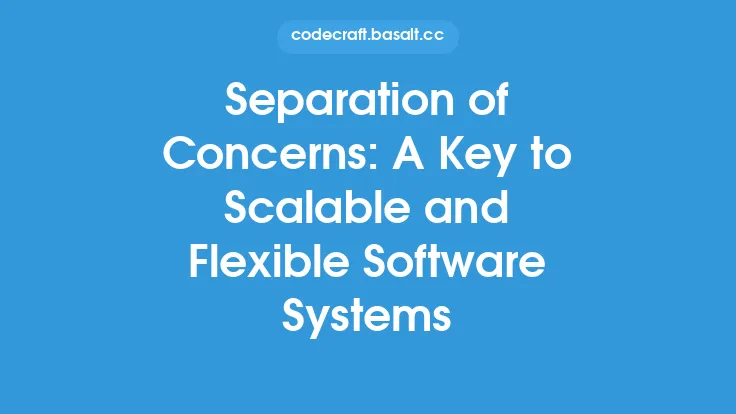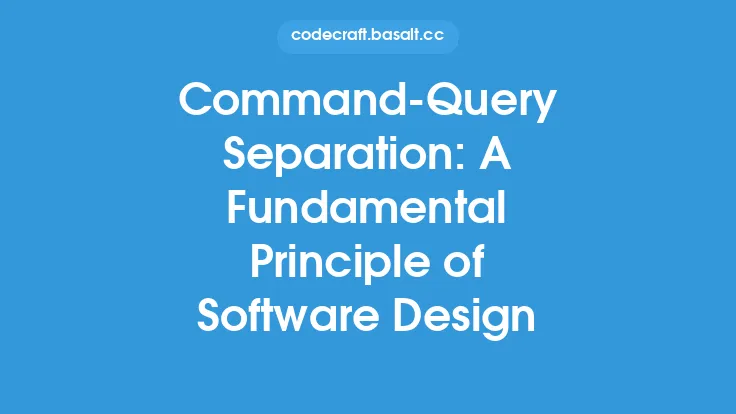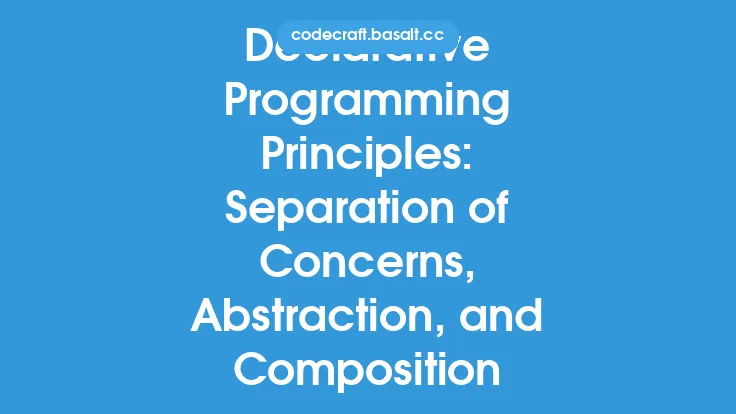Separation of concerns is a fundamental principle of software architecture that emphasizes the importance of dividing a system into smaller, independent components, each responsible for a specific aspect of the system's functionality. This principle is based on the idea that a system should be designed to separate its various concerns, such as presentation, business logic, and data storage, into distinct modules or layers. By doing so, developers can create systems that are more maintainable, scalable, and flexible.
History and Evolution
The concept of separation of concerns has its roots in the early days of software development. In the 1970s, computer scientists such as Edsger Dijkstra and David Parnas began to advocate for the idea of separating concerns as a way to improve the design and development of software systems. They recognized that complex systems were difficult to maintain and modify, and that a more modular approach was needed. Over time, the principle of separation of concerns has evolved and been refined, with various software architecture patterns and frameworks emerging to support its implementation.
Key Principles
The principle of separation of concerns is based on several key principles. First, it emphasizes the importance of identifying and separating the various concerns of a system. These concerns may include presentation, business logic, data storage, and networking, among others. Each concern should be addressed by a separate module or layer, with well-defined interfaces and APIs. Second, it stresses the need for loose coupling between modules, to minimize dependencies and facilitate maintenance and modification. Finally, it promotes the use of abstraction and encapsulation to hide implementation details and expose only the necessary information to other modules.
Architectural Patterns
Several software architecture patterns have emerged to support the principle of separation of concerns. One of the most well-known is the Model-View-Controller (MVC) pattern, which separates an application into three interconnected components: the model, which represents the data and business logic; the view, which handles presentation; and the controller, which manages the interaction between the model and view. Other patterns, such as the Layered Architecture pattern and the Service-Oriented Architecture (SOA) pattern, also embody the principle of separation of concerns. These patterns provide a framework for designing and implementing systems that are modular, flexible, and maintainable.
Benefits and Advantages
The principle of separation of concerns offers several benefits and advantages. By separating concerns, developers can create systems that are more modular and easier to maintain. Each module or layer can be modified or replaced without affecting other parts of the system, reducing the risk of introducing bugs or causing unintended consequences. Separation of concerns also promotes reusability, as individual modules or layers can be reused in other contexts. Additionally, it facilitates scalability, as new modules or layers can be added as needed to support growing demands or changing requirements.
Technical Implementation
From a technical perspective, implementing the principle of separation of concerns requires careful planning and design. Developers must identify the various concerns of a system and design separate modules or layers to address each concern. They must also define clear interfaces and APIs to enable communication between modules, and use abstraction and encapsulation to hide implementation details. In object-oriented programming languages, such as Java or C#, developers can use techniques such as inheritance, polymorphism, and dependency injection to implement separation of concerns. In functional programming languages, such as Haskell or Scala, developers can use techniques such as higher-order functions and type classes to achieve similar goals.
Challenges and Limitations
While the principle of separation of concerns offers many benefits, it also presents several challenges and limitations. One of the main challenges is identifying the optimal granularity of modules or layers, as too much separation can lead to complexity and overhead, while too little separation can compromise maintainability and flexibility. Another challenge is managing the dependencies between modules, as tight coupling can undermine the benefits of separation of concerns. Additionally, separation of concerns can require significant upfront design and planning, which can be time-consuming and costly. Finally, it may not always be clear how to separate concerns in a system, particularly in cases where the concerns are tightly intertwined or complex.
Conclusion and Future Directions
In conclusion, the principle of separation of concerns is a fundamental principle of software architecture that emphasizes the importance of dividing a system into smaller, independent components, each responsible for a specific aspect of the system's functionality. By separating concerns, developers can create systems that are more maintainable, scalable, and flexible. While implementing separation of concerns can be challenging, the benefits it offers make it a crucial principle to follow in software development. As software systems continue to evolve and become more complex, the principle of separation of concerns will remain a vital guide for developers seeking to create systems that are modular, flexible, and maintainable. Future research and development will likely focus on refining and extending this principle, as well as exploring new techniques and technologies for implementing separation of concerns in software architecture.





